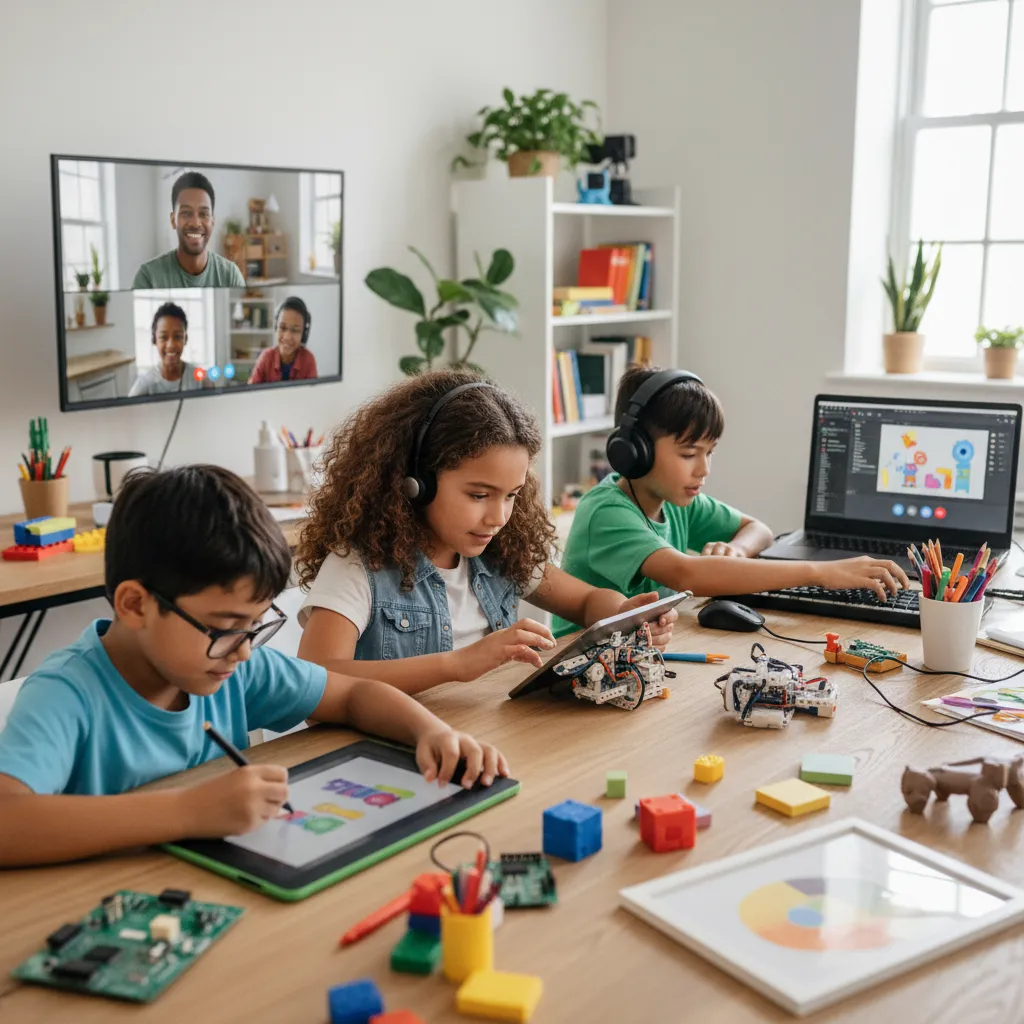STEM and Creative Online Classes for Kids: Preparing for the Future
In a world where technology and creativity converge, preparing children for the future means giving them both analytical tools and imaginative freedom. As a marketer with a decade of experience observing education trends, I’ve seen how STEM and creative online classes for kids deliver practical skills, spark curiosity, and open doors to new careers. This article explains why these programs matter, how they’ve evolved over time, and how parents and educators can choose high-quality options that build resilience, problem-solving, and creative confidence.

The early days: how online learning began to expand opportunities
Online learning did not start as the ubiquitous choice it is today. Early efforts focused on replicating classroom lectures digitally, often with limited interactivity. Still, even in those primitive days, parents and pioneers recognized that distance learning could break geographic barriers - giving children access to specialized subjects that their local schools couldn’t offer. The first wave introduced recorded lessons, email feedback, and basic learning management systems that slowly proved the model’s viability.
Those early experiments planted the seed for more ambitious programs. As bandwidth and platforms improved, the foundation for STEM and creative online classes for kids was laid: structured content, teacher-led sessions, and eventually interactive tools that allowed hands-on projects to happen remotely. From the perspective of someone watching education markets, that shift transformed online learning from a novelty into a strategic option parents take seriously.
The acceleration phase: why demand surged (and continues to grow)
When the world faced sudden disruption, demand for robust online options accelerated sharply. Families discovered that high-quality instruction could happen virtually - sometimes better tailored to individual needs than a crowded classroom. This acceleration pushed developers, schools, and startups to focus on user experience, assessment tools, and more scaffolded lesson plans. The result: a broad ecosystem of online offerings ranging from coding camps to virtual art studios.
For marketers and program designers, the lesson was clear: parents want outcomes. They want their children to gain confidence, measurable skills, and creative output. That’s why many platforms now emphasize project portfolios, badges, and public showcases - concrete proof that STEM and creative online classes for kids are producing real learning.
Present-day landscape: types of classes you can find now
Today, the online marketplace for kids’ learning is diverse. You can find asynchronous micro-lessons, live small-group classes, mentorship-driven programs, and hybrid kits that combine physical materials with virtual instruction. Popular categories include:
- Coding and computational thinking (block-based tools to Python)
- Robotics and maker projects (kits plus virtual instruction)
- Digital art and animation (drawing tablets and software)
- Music production and audio engineering (DAWs tailored for kids)
- Storytelling, writing, and multimedia creation
Each of these categories maps to an educational goal: practical technical skill, design thinking, collaborative problem-solving, or expressive creativity. When I evaluate platforms as a marketer, I look for clarity in outcomes, evidence of student progress, and opportunities for public recognition - things parents value.
Why STEM skills matter: foundational advantages for future careers
STEM education builds pattern recognition, logical reasoning, and structured problem-solving. Those are foundational skills employers will continue to prize, especially as automation reshapes job roles. Early exposure helps children develop fluency in the language of technology: variables, algorithms, systems thinking. This fluency translates into better performance in high school STEM courses, improved standardized test readiness, and a head start for specialized tertiary studies.
More importantly, STEM training fosters a mindset: experiment, iterate, and learn from failure. That mindset is as valuable as any technical language because it prepares kids to adapt when tools and job descriptions change. For parents hoping to invest wisely, STEM and creative online classes for kids offer a two-fold benefit - technical literacy and entrepreneurial habits.
Real-world examples of STEM impact
- Children who start with block-based coding often transition more easily to text-based programming.
- Robotics competitions teach systems engineering as well as teamwork and project management.
- Data and math enrichment programs build confidence for quantitative subjects later in life.
Why creativity is equally essential: more than just art
Creativity is not an optional extra; it’s a competitive advantage. Creative thinking allows children to design better user experiences, pivot business ideas, and solve problems that don’t have an obvious algorithmic solution. Whether kids learn animation, storytelling, or musical composition, they develop empathy, aesthetic judgment, and narrative skills - abilities that improve communication and leadership.
Pairing creativity with technical skills produces uniquely capable learners: someone who can code an app and also design an intuitive interface; a young engineer who thinks about cultural impact and user delight. That synthesis is exactly what employers in design-driven industries look for.
Creativity fosters emotional intelligence
Creative projects give children opportunities to explore identity, manage frustration during a difficult build, and celebrate expressive achievements. Those emotional learning outcomes complement measured skill gains from STEM classes and make online learning more meaningful.
How STEM and creative classes complement each other: integrated learning models
The best learning experiences for kids blend technical rigor with creative projects. Consider a game-design course: students learn programming logic (STEM), craft characters and story arcs (creative), and prototype playable levels (design thinking). This combination reinforces learning because children see how abstract concepts are used to make something people enjoy.
Integrated models also mimic real-world work. Few careers require pure coding or pure art; most demand the translation of technical solutions into human-centered results. By enrolling in combined courses, children build interdisciplinary thinking early - an enormous edge in future studies and careers.
Examples of integrated project types
- Game design: coding + storytelling + graphic assets
- 3D printing: CAD modelling + engineering tolerances + artistic finishing
- Interactive music: composition + signal processing + UX for interactive apps
Benefits parents and kids notice: outcomes beyond test scores
Online STEM and creative classes produce measurable and intangible benefits. Measurable gains include coding badges, completed projects, and technical certificates. Less tangible but equally important outcomes are improved perseverance, better collaboration in group projects, enhanced curiosity, and sustained engagement in learning.
From a parental viewpoint, another major benefit is accessibility. Families in remote areas can access top instructors; kids with niche passions find peers globally; working parents gain scheduling flexibility. When choosing programs, parents should look for evidence of both skill mastery and soft-skill development.
Common challenges and how to address them
Although online education offers many advantages, challenges exist. Screen-time concerns top the list: excessive passive viewing is unhealthy. The solution is to prefer interactive classes that require hands-on construction, offline activity, and movement. Another challenge is motivation: without a physical classroom, some children lose focus. Gamified learning, small-group cohorts, and project deadlines help maintain momentum.
Quality control is also a challenge - how do you distinguish a marketing brochure from a rigorous curriculum? Parents should examine instructor credentials, sample lessons, student portfolios, and reviews. Trial classes and refund policies reduce risk.
Practical mitigation strategies
- Limit passive screen time; require offline project steps every week.
- Use trial lessons to assess engagement before committing to multi-month plans.
- Prioritize platforms that offer live instructor feedback over purely recorded content.
How to choose the right program: a checklist for parents
Choosing the right program is both art and science. Use this practical checklist to evaluate options:
- Clear learning outcomes: What will the child be able to do after completion?
- Age-appropriate curriculum: Is content designed for the child’s developmental stage?
- Instructor qualifications: Are teachers experienced and trained for online delivery?
- Interactivity: Does the course require active creation and feedback?
- Evidence of success: Are there student portfolios, testimonials, or case studies?
- Community and collaboration: Are there group projects or peer reviews?
- Flexibility: Can lessons fit your family schedule without long interruptions?
- Cost and trial options: Is there a free trial or money-back guarantee?
- Safety and privacy: Does the platform protect children’s data and moderate interactions?
- Technical requirements: Does your home have the necessary hardware and internet speed?
Using these ten criteria helps parents filter countless options and find programs that align with long-term goals for their child.
Practical tips for maximizing learning at home
Enrolling is only the first step. To maximize the benefit of STEM and creative online classes for kids, follow these practical tips:
- Create a predictable schedule: Regular sessions help establish habits.
- Set up a learning space: A dedicated desk or corner reduces distractions.
- Encourage a project portfolio: Save projects to showcase progress and motivate improvement.
- Balance screen and hands-on work: Many STEM activities require offline experimentation.
- Provide mentorship: Parents and older siblings can serve as project buddies or cheerleaders.
- Celebrate milestones publicly: Sharing work with family motivates children.
These operational steps amplify the program’s efficacy and help children translate sporadic learning into sustained growth.
Looking forward: skills that will matter in the next decade
Thinking as a marketer and strategist, I expect demand for hybrid skills - technical depth paired with creativity - to continue rising. Areas likely to be especially valuable include:
- Human-AI collaboration: Understanding how to design and supervise AI systems
- Computational creativity: Algorithms that produce art, music, and design
- Sustainable engineering: Technical solutions for climate and resource challenges
- Digital fabrication: 3D printing and rapid prototyping combined with industrial design
- Data literacy for creators: Translating analytics into creative strategy
Children who cultivate curiosity, adaptability, and a portfolio of interdisciplinary projects will be the best-prepared to seize opportunities as industries evolve.
Conclusion
Investing in STEM and creative online classes for kids is more than a short-term enrichment choice - it’s a strategic pathway to future readiness. These programs teach technical skills, ignite creative thinking, and build a resilient mindset that thrives on experimentation and iteration. For parents, the key is to choose programs that demonstrate clear outcomes, balance technical rigor with creative expression, and support consistent practice. With the right choices and home support, children will develop the capabilities to innovate, collaborate, and lead in a future shaped by rapid technological and cultural change.











